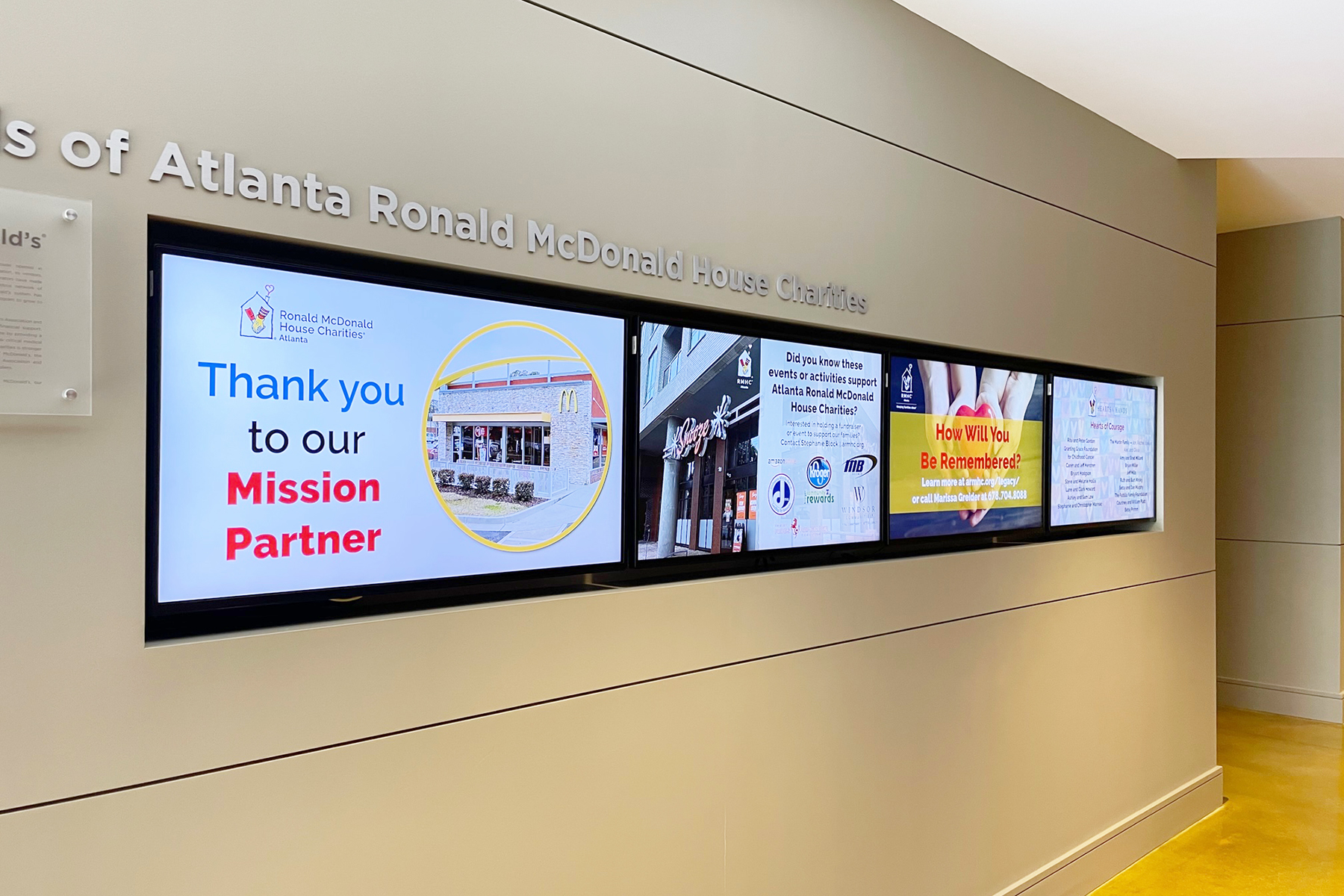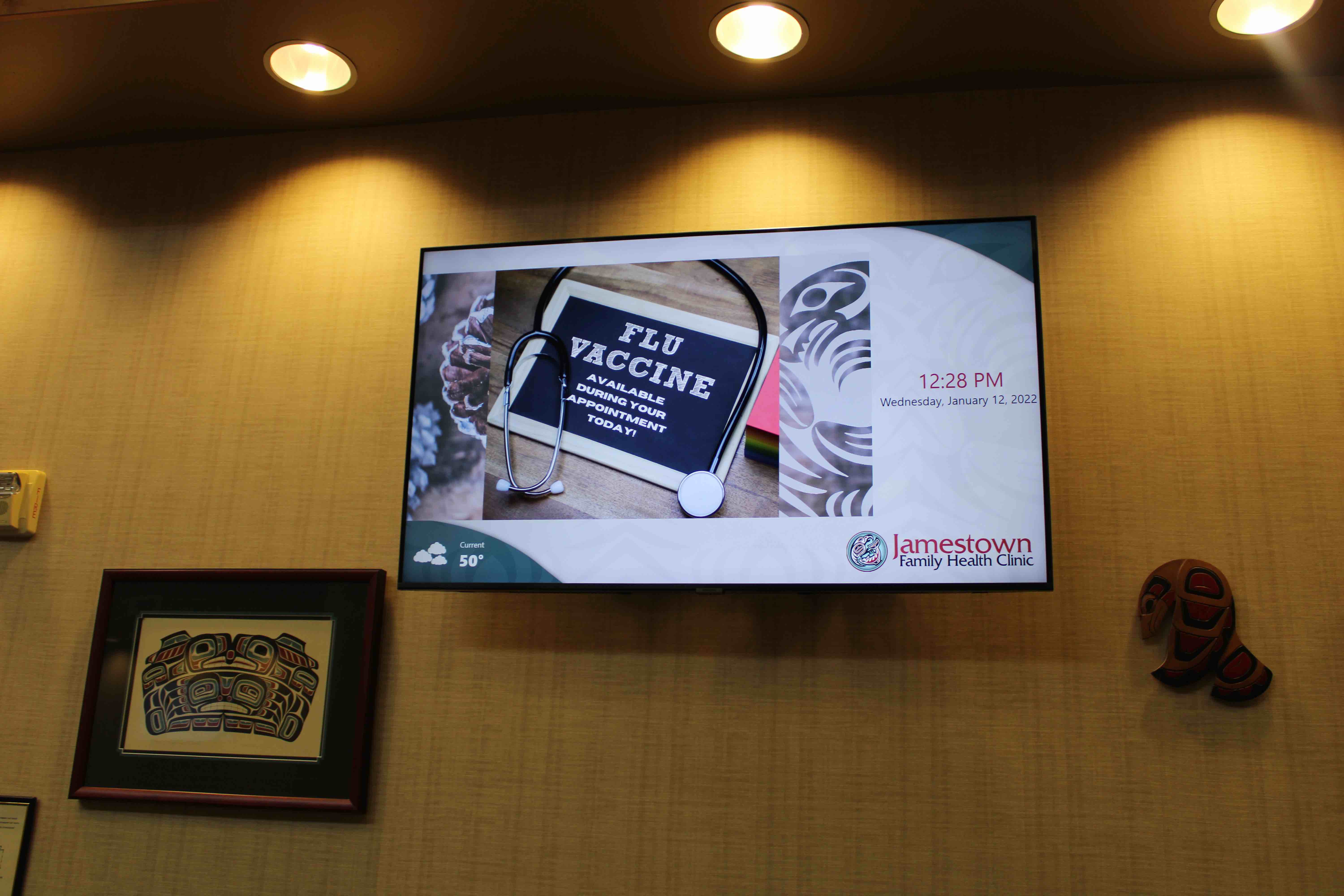Healthy Communication
Integrators can add value to healthcare digital signage.

Healthcare facilities have varied communications needs for both outward-facing and internal messaging. Whether it’s the delivery of infotainment to waiting areas and patient rooms or critical care notices at nurse stations, hospitals and clinics increasingly leverage digital signage technology to keep visitors, patients, and staff informed in real time.
The use cases are diverse and some, notably on the interactive side, are often more prevalent in healthcare than other verticals. One example of this is wayfinding, the most common digital signage application we see in hospitals today.

Large hospitals are notoriously difficult to navigate. Intuitive touchscreen kiosks—much sleeker and aesthetically appealing than the clunky units of yesteryear—give visitors multiple ways to locate their destination depending on their preference, and relieve them of further stress.
For example, they can choose to receive a printed set of directions, scan a QR code, receive a text message, or access wayfinding instructions through an app. Also, these systems can be programmed to support multiple languages on a single display, allowing non-English speakers—or those for whom English is a second language—a more comfortable way of getting the information they need.
It's no secret that digital signage is the platform that businesses and organizations turn to when there’s a desire to modernize their communications strategies.
Hospitals also leverage digital signage kiosks for patient check-in, reducing the burden on hospital staff. In non-emergency scenarios, the patient registers via a kiosk with built-in blinders (for privacy purposes) or a tablet. The individual is assigned a code (also for privacy purposes) and is entered into the queuing system. Patients can then monitor their progress—from check-in to consultation to the X-ray room—to determine where they are in the outpatient care process.
[Visix Names New COO and Is Certified as a Veteran-Owned Small Business]
Healthcare professionals now take advantage of digital signage when meeting with peers, too. At Hawaii Pacific Health, guests can access wayfinding and session information through interactive displays powered by Visix AxisTV Signage Suite software. The screens provide information on what happens in each conference room, as well as their location in the facility. Users can also access a directory to perform keyword searches for specific events.
A daily selection of features, industry news, and analysis for AV/IT professionals. Sign up below.
Modernized Messaging
It's no secret that digital signage is the platform that businesses and organizations turn to when there’s a desire to modernize their communications strategies. The main reason is often to efficiently provide important updates to audiences in a timely manner that also captures attention in a compelling way—something that print, email, and other visual communication methods simply don’t achieve.

The Atlanta chapter of Ronald McDonald House Charities—an organization that provides lodging to families whose children are in treatment at nearby hospitals—has taken an intriguing approach by using digital signage to communicate time-sensitive information to the families it serves. With displays positioned in high-traffic hallways, the system also runs content that tells the story of Ronald McDonald House and its current missions, as well as "thank you" messaging to donors and volunteers.
A more common approach to modernized healthcare facility messaging can be found at the Jamestown Family Health Clinic in Sequim, WA. Owned by the Jamestown S’Klallam Tribe, this is one of the largest family practices on the Olympic Peninsula, with 26 primary care providers and 18,000 active patients. Previously, the facility relied on its already busy staff members to manually post written notes in its waiting room to communicate important information to patients.
Now, the facility can deliver more consistent, real-time communications with its new digital signage system, which features two 50-inch video displays positioned at opposite ends of its large lobby area. Jamestown also benefits from a digital signage-focused Hardware-as-a-Service (HaaS) package, a subscription-based OpEx solution that enabled the clinic to avoid incurring a capital expense to invest in the necessary gear for the new system.
Managed Service Opportunities
The shift from CapEx to OpEx is a familiar transition that we’ve seen trickle down from the IT space to Pro AV, including the digital signage sector. Healthcare professionals, already stretched thin prior to the pandemic, are now seeking to reduce their capital expense budget while also outsourcing management, maintenance, and other tasks to lessen these burdens on in-house staff.

Managed service offerings that include 24/7 remote monitoring keep integrators in front of these clients and allow for troubleshooting and resolution, often before the customer is aware that an issue has occurred. Integrators that offer these post-installation services can help hospitals and clinics operate more smoothly, while strengthening their client relationships and establishing new, ongoing revenue sources.
[Editorial: Digital Signage Future Is Bright]
Similarly, partnering with suppliers that offer subscription-based packages extends the value of the managed service plan coming from the integrator, as the latter pairs ideally with the subscription model. Institutions that are reticent to commit to CapEx procurement models will find the quickly emerging HaaS offerings taking shape around the AV industry attractive.
Often, the entire hardware portion can be written off as an OpEx expense; in the case of a Visix HaaS plan, media player ownership is never transferred to the client. Instead, a monthly cloud and player subscription is bundled with the media player itself.
Emerging Needs
As is the case with all markets this industry serves, healthcare has its unique needs and quirks. Analytics is one technology area that will help end users in most industry verticals address audience needs moving forward. This is particularly true when used with retail and hospitality networks, as analytics can help clients better understand audience behaviors, as well as the effectiveness of out-of-home ad campaigns.
In healthcare, the value of analytics will be more about tracking audience numbers, such as participation in blood drives. This is a very new technology that will rapidly emerge for varied use cases, but we see analytics as a dynamic toolset for better understanding contributions, consumer reactions, and overall effectiveness of a digital signage campaign.
For AV integrators, understanding the unique needs of healthcare means investing the time in discovering and understanding what each customer wants to achieve when it comes to patient, employee, and visitor experience, and how digital signage can help them get there. In making this effort, they position themselves as the long-term, trusted partner that healthcare facilities can continually call upon as they scale their systems upward and further explore what digital signage technology has to offer.
Sean Matthews is CEO and President of Visix Inc., which offers a robust suite of digital signage software, content designs, and meeting room signs for organizations that want to engage, excite, and inform their audiences.

